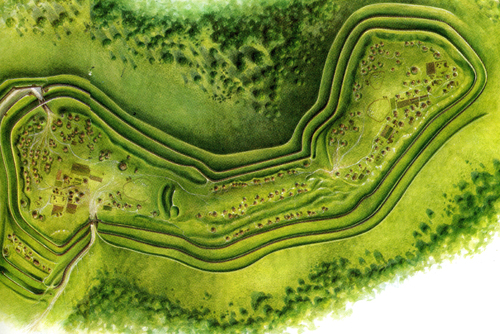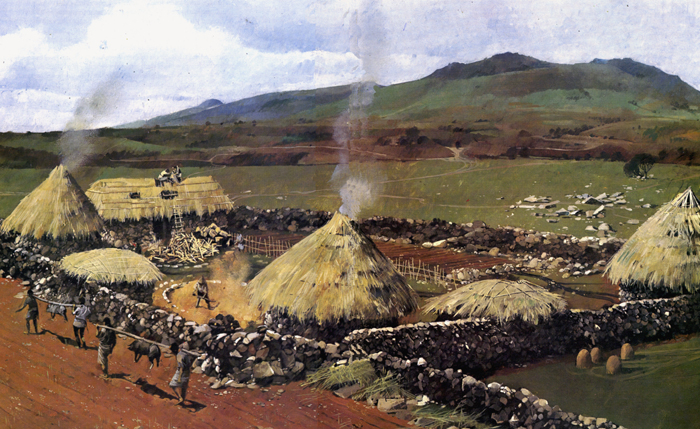|
Celtic Houses and Villages
The Celts of Britain and Europe usually lived in small villages or farmsteads. There were also larger towns like Camulodunum (now called Colchester), which were spread over a large area. Some iron age villages were hill forts, set on the top of hills with wooden fences, earth ramps and ditches, for protection against enemies.
In some settlements there were the workshops of craftsmen such as bronzesmiths, blacksmiths, and goldsmiths. There were also cemeteries and sacred areas like temples, as well as houses, animal pens and storage huts.
The Celts of Britain lived in a number of tribes which are now known by the Latin versions of their names. This map shows where in Britain they lived. |
Maiden Castle in Dorset. An iron age hill fort with an intricate maze of ramps and ditches, which were supposed to delay and confuse attackers. The picture below is a reconstruction of what another Celtic hill fort in Dorset, Hambledon Hill, might have looked like. |
|
|
|
|
Celtic Farms
These pictures show reconstructions of Celtic farmsteads. Animals such as cows, pigs and sheep were farmed and looked after in pens. Some huts were used as granaries, and most buildings were surrounded by wattle fences (made of long thin sticks woven together).
Animal pen. At the reconstructed iron age village at Butser Hill, Hampshire
|
Reconstruction of a farmstead at Whitton, South Wales, dating to around the time of the Roman conquest (AD43). This one has a ditch and a wooden fence for protection (and to keep animals in) |
|
Celtic farmstead in North Wales, dating to the 3rd century AD. The family is preparing for the winter: you can see smoke rising from chimney holes as women cure meat, men carrying pigs that will be fattened for slaughter, a man winnowing wheat and barley (throwing it up into the air to get rid of the chaff, the part you can't eat), a small hut to store logs for winter fires, and men fixing a barn for storing hay for the cattle.
|
|
|
Celtic Houses
The Celts lived in round houses with only one or two rooms, up to about 20 feet (6m) across. The wall at the bottom was made with wattle and daub - a fence of woven sticks was filled in with mud and supported by strong logs. On top of this lots of poles were arranged to make a cone, lashed together at the top, and covered with thatch (thick layers of straw tied on to the poles).
The floor was usually clay, perhaps with straw and animal skins for warmth and comfort. Often there would be a hole in the roof to let smoke from fires out.
As well as eating and sleeping various other activities went on inside these round houses. The pictures below show scenes from Butser Hill, a reconstructed Celtic village in Hampshire.
|
Reconstruction of a Celtic round house at Butser Hill |
|
Above: a loom for weaving wool from sheep. The cloth would be coloured with vegetable dyes, and perhaps woven in a tartan-like pattern.
A round house with a stone wall |
Animal hides hanging. Hides were used for bedding and clothing. Women would cure the hides (use salt to stop the hide from rotting), and then the smoke from the fire would help to tan them (preserve them).
A clay oven. Food could be roasted, boiled, or baked by standing it on a ledge above the fire. |










